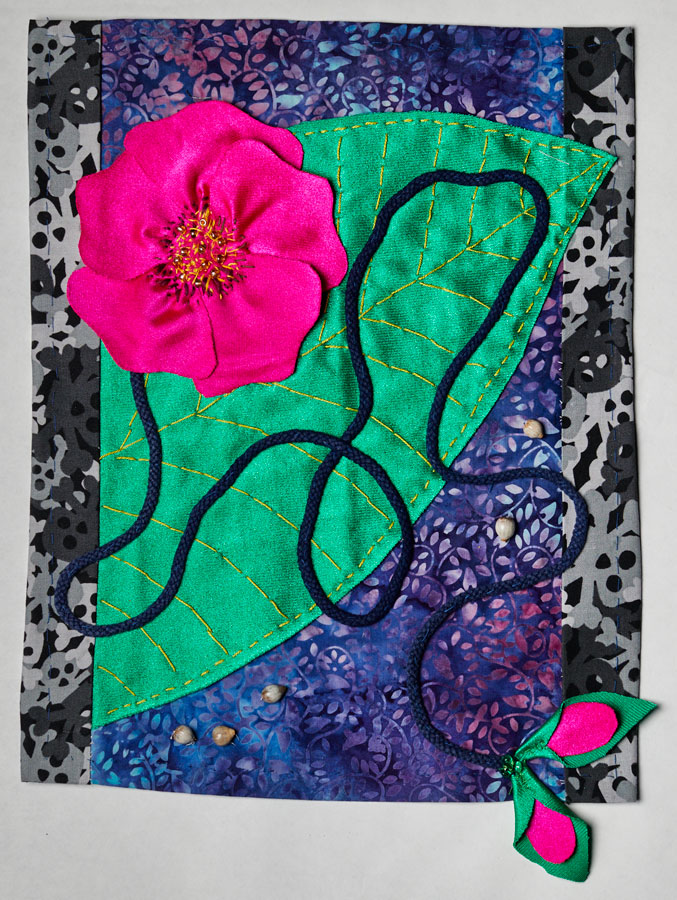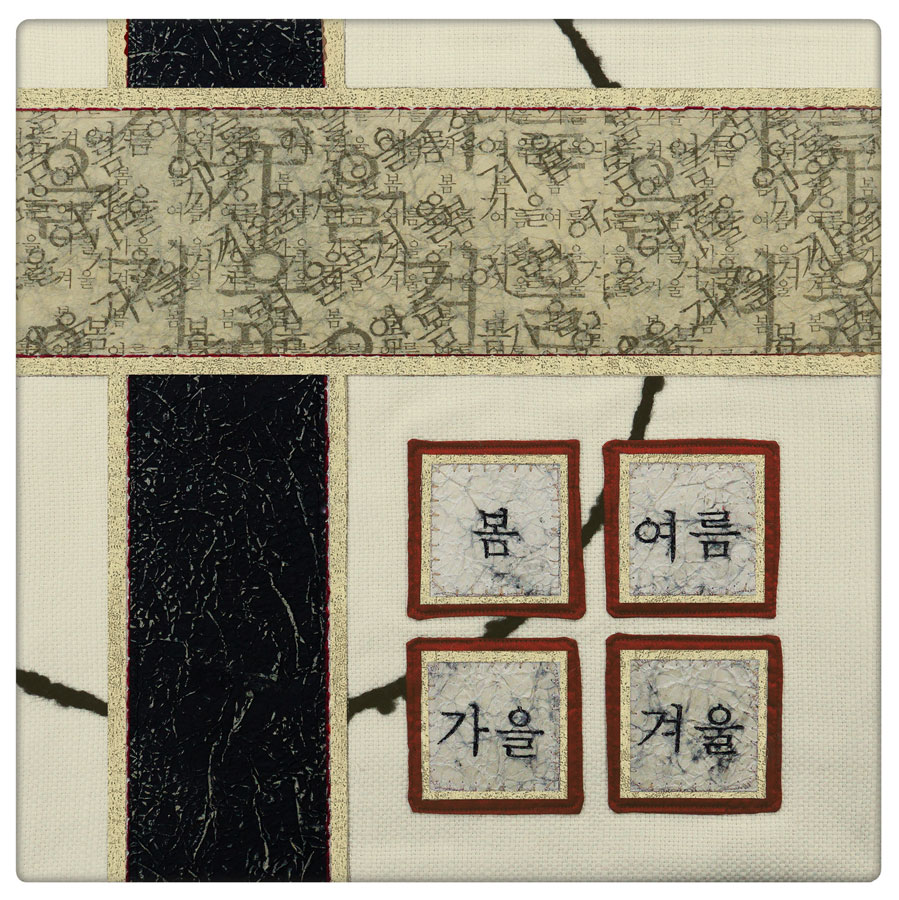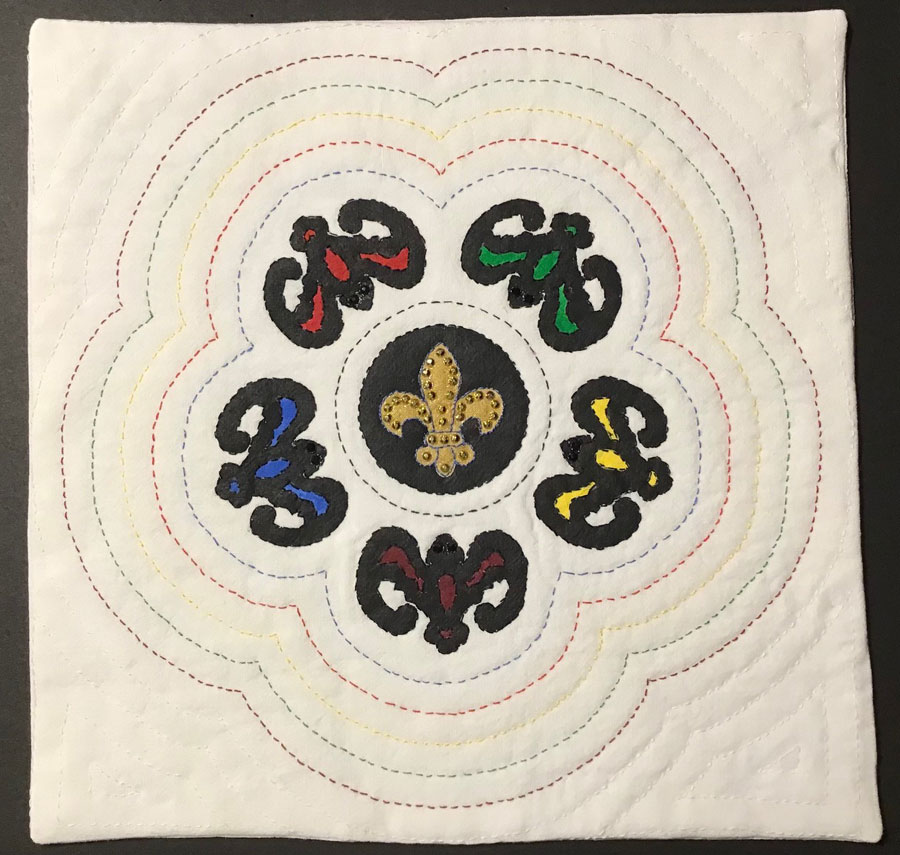
Cradle to Grave, Birth to Death was the theme of the first Korea Fiber Art Forum held in Suwon, South Korea from September 21 through September 27, 2022. LAFTA was invited to participate as a part of this rich cultural exchange. 20 participating LAFTA artists researched the culture and fiber art traditions of South Korea and created new work as a response to the theme for this group installation. After exhibition in South Korea, the LAFTA work was also shown in Louisville at the Crane House and also at Gallery 104.
Contributing Artists not pictured: Elmer Lucille Allen, Joyce Anderson, Wendy Dunleavy, Joanne Rouse and Pat Sturtzel

Title: Holding on and Letting Go
by Amy Sloboda
Artist’s Statement:
The process of hand weaving is both ancient and modern and the preservation of this medium is central to my work as an artist and a maker. The theme “From Birth to Death” is symbolically relevant to cloth construction as the wearing and touching of cloth is an integral part of life from beginning to end. From the moment we are born until the day we die, our bodies are wrapped in cloth. The graphics in this piece are inspired by Korean walls and doors and were also inspired by bojagi piecework and nubi stitching. The hardy Mugunghwa plant represents resilience and growth, blooming season after season despite sometimes challenging growing conditions. The blue butterfly is a symbol of hope and transformation, and, by contrast has a lifespan of only a few weeks. Cradle to Grave, Birth to Death, life for all people can be long, as represented by the hardy Mugunghwa plant, or short, like the butterfly.

Title: Moon Over Water: A Tribute to the Haenyeo Women of Jeju Island
by Becky Hunger
Artist’s Statement:
In researching Korean culture, I became fascinated with two intersecting ideas and practices: the moon as a symbol of the feminine and the haenyeo divers of Jeju Island. These women were talented, fiercely independent and physically and mentally strong. They harvested seafood from the sea using their own stilled breath and minimal equipment.
The divers were dedicated and relentless, continuing the practice of diving throughout their lives. They began when they were young women, continued diving while they were pregnant, and became leaders and mentors for younger haenyeo’s in adulthood. At age 55, they were expected to retire.
When a girl child was born, the birth was celebrated. The child would be brought up surrounded and encouraged by women who embraced the water as part of their lived experience in the hopes that she too would become a haenyeo.
While becoming a haenyeo was celebrated, it wasn’t without risk. The many dangers including being attacked by sea animals, losing consciousness or becoming trapped by underwater caverns. Despite this, the women spent a large part of their lives diving in the sea and enjoying the freedom it gave them. Some lost their lives in these same waters and in the pursuit of their dreams.
This piece is a tribute to all the women who were a part of the haenyeo community of divers from birth to death and to women everywhere who follow their dreams.

Title: Continuance
by Beth Schnellenberger
Artist’s Statement:
Life is a colorful chaotic combination of events from birth to death. Periods of calm are surrounded by periods of calamity and excitement.

Title: Circle of Life
by Beth Schnellenberger
Artist’s Statement:
A circle is quite mystical Dash the circle in the sun, moon, and earth; the planets spinning through the heavens; the circle in a wheel; the dome of a church; the circle of a wedding ring. Plato said the soul is a circle. Life is a circle from birth to death.

Title: Untitled
by Bette Levy
Artist’s Statement:
A circle is quite mystical Dash the circle in the sun, moon, and earth; the planets spinning through the heavens; the circle in a wheel; the dome of a church; the circle of a wedding ring. Plato said the soul is a circle. Life is a circle from birth to death.

Title: First Birthday
by Felice Sachs
Artist’s Statement:
First Birthday is designed to represent a narrative of that very special occasion in the life of a child, his/her family and their extended community. It may be highly celebrated with traditional and modern interpretations. The child is treated as royalty with an abundance of food and iconic symbols for long life, evading evil spirits, innocence and fertility.
Aspects of this joyous day are recognized in First Birthday fiber collage by the special Hanbok outfit a child wears, the use of obangsaek – traditional Korean colors, and by colorful hand embroidery recognized as an important means of decorating life with beauty. Other symbolic messages are implied, for instance, in the appliqués of a bat, a fish, the flowers, a deer and a yin yang circle.

Title: Rose of Sharon
by Fran Englander and Judi Magder
Artist’s Statement:
Rose of Sharon, the national flower of Korea, also grows abundantly in Kentucky. In our piece, we represent the Rose of Sharon as seed, bud, and full bloom, bordered by a skeleton print in white, black, and gray, marking the looping path of life from cradle to grave.

Title: A Full Life
by Joanne Weis
Artist’s Statement:
In this piece, I have used materials and process that represent my understanding of the Korean customs surrounding death. Hemp is the fabric used for the burial garb. Black is the color of mourning. Red is associated with death with a custom of never signing your name in red. The symbol representing death is shown. This is pieced simulating the Korean technique of Pojagi. If you view each section as different periods in one’s life, all of these are connected, themes and stories traveling through and around the different times of a life time, culminating in death.

Title: A Mother’s Love In The Process Of Time
by Judy Layne-Banks
Artist’s Statement:
The Hecton or handsewn technique is combined with embroidery, applique and quilting to depict a peasant Korean girl with her baby , next to a traditional Korean home called a Hanok.
The cycle of life begins with the bond between the Mother and Child and this image is embroidered in the middle of the design. Layers of fabric in the hecton and traditional colors are used to show the journey from birth to death.
The young Korean mother is wearing a colorful headwear to celebrate the birth of her child. Both the faces of the mother and child are outlined with embroidery stitches :their peasant home is also embroidered and a garden is included in the design to celebrate the child’s birth.
Tiny leaves are arranged around the face of the design to show the passing of time.
Soft light colors such as like pale green leaves on the left side of the design, represent youth, on the right side of the fabric the leaves of darker tones represent the harshness of old age and death.
The design is a tribute to my mother who embroidered designs of the ‘Mother and Child theme as her art form.
I have inherited all my mother’s skills of art and design.

Title: Gently Sloping Roofs
by Karen Buckingham
Artist’s Statement:
I’ve become very intrigued, fascinated and charmed by the majestic Korean buildings decorated with the vibrant hues of red, blue, and green. The symbolism behind South Korea’s beautifully painted temples, referring to the five-colored designs is known as Dancheong. All Dancheong designs use the same five basic colors, blue, red, black, white and yellow which can be mixed to form countless other colors. They epitomize the Korean desire for stability and peace in the present life, while working towards a rewarding afterlife.
Throughout time, Dancheong has spread from places of eternal rest to other buildings of prominence, found on walls, pillars and eaves. The vibrant designs convey the importance and status of the residents and also preserves and protects the wooden structures from the weather.
The many alluring Korean structures with sloping roofs, and especially the habitable ones, provide sanctuary for those living within. The unique architecture and beautiful Dancheong art in the eaves support both the buildings and their inhabitants.
The stability and peace of these Korean structures provide support and protection throughout the entire lives of people, from cradle to grave, and were the inspiration for my piece, Gently Sloping Roofs. The designs, patterns, colors and repetition used make up my fabric interpretation of these magnificent Dancheong buildings.

Title: Seasons: The Cycle of Life
by Linda Witte Henke
Artist’s Statement:
I chose to interpret the exhibition’s “Cradle to Grave” theme using the four seasons of nature. Korean text for the seasons — spring, summer, autumn, winter — appears both in the cluster of four squares and in the horizontal band that traverses the work. These elements, as well as the vertical band, were created from papers that were transformed using a Japanese process known as “momigami.”
Traditional Korean colors are reflected in the off-white background and the black, red, and gold accents. Strands of multiple types of yarn were couched onto the background to create a circle to further convey a sense of life cycle. The work was embellished with machine- and hand-stitching.

Title: The Riddle of the Sphinx
by Miriam Forinash
Artist’s Statement:
The riddle of the Sphinx reflects the theme Birth to Death. It asks what creature has one voice, but has four feet in the morning, two feet in the afternoon, and three feet at night? Oedipus managed to answer correctly; he replied, “the man” who crawls on all fours as a baby, walks on two as an adult, and needs a walking cane when old.
Source: https://www.greekmythology.com/Myths/Monsters/Sphinx/sphinx.html
I wanted to use both Korean techniques, bojagi and traditional quilting to create a cross cultural piece depicting the riddle of the Sphinx.

Title: Emergence
by Sue Yung
Artist’s Statement:
The road from birth to death has many transitional points where present resources are used to meet new challenges.
Directional hand quilting is used throughout this piece to emphasize that journey. A patch work design with primary Korean colors is combined to make something new. Fabrics and triangular shapes remain the same but secondary hues of green, orange, and purple emerge. Thus a boy becomes a man!

Title: Bats and Blessings
by Sue Sobel
Artist’s Statement:
In a book on Korean art, I found a photograph of 19th century wedding pillow ends that featured five bats. I explored the meaning of the bat symbol and how it related to the theme of marriage. To create my own bat symbol I looked to bat images found on wedding chests and architectural details.
Bats symbolize longevity and good fortune and are frequently seen on wedding presents for newly weds. There are five bats (Obok) in my artwork representing the Five Great Blessings – wealth, health, long life, love of virtue and peaceful death. Traditional colors are used in the bats and stitching threads. In the center of my artwork is a Fleur de Lis, the symbol for Louisville, my hometown. After moving to Louisville I soon met my husband and our 46 years of marriage has had many blessings and longevity!

Title: Vickie to Una: From the Cradle to the Grave
by Vickie Wheatley
Artist’s Statement:
I interpreted the theme (From the Cradle to the Grave) as two generations of women, my mother and me, from my birth to her death.
My mother was a master sewist. She used cotton batiste to make heirloom dresses for her granddaughters and linen to create fine table linens. Upon her death in 2017, I inherited her beautiful fabrics, all white, some of which I hand-dyed and used to create this artwork.
I’m a patchwork quilter, so it was natural for me to choose a Korean patchwork style, or Bogaji, to create this piece. The shapes in the center of piece represent a cradle (white) and a coffin (black). In the center is a yellow rectangle, signifying fertility. The silk ribbon flowers made by my mother echo the ribbon often used in the center of Bogaji patchwork wrapping cloths. The inner rectangle and outer perimeter are bound in red to signify the pursuit of happiness, solidarity, and protection from evil spirits.
